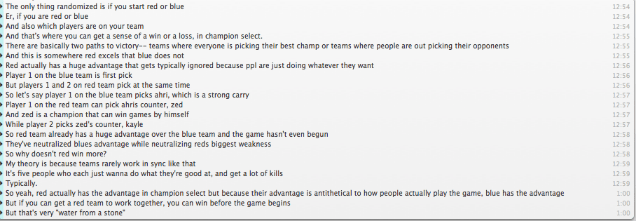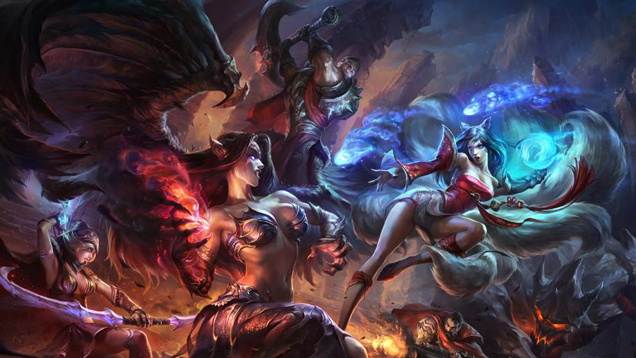Red versus Blue. Shirts versus skins. Zombies versus humans. These are all surface level distinctions, saying nothing meaningful about one team’s likelihood of trouncing the other… right?
If only there was some way to quantify the results of many different matches of a particular game and then use this information to come to a conclusion.
Big data to the rescue! In a report published this morning, The Daily Dot tracked well over two hundred matches of League of Legends to see if playing on team Blue or Red gives players a better chance of winning.
The results were surprising, to say the least.
“In over 224 games, the Blue side team won 34 times more than the Red side,” author Ferguson Mitchell wrote. “At 129 wins, that’s a 30 per cent difference between the opposing sides.”
Blue teams also won nearly a third of games against Red teams that were ranked above them, the report goes on to say. And, perhaps less surprisingly, Blue teams won a lot more games played against teams ranked below them compared to Red teams in the same situation.
“These kinds of statistics speak to the depth of strength that the Blue side has,” The Daily Dot concludes. “Despite being matched up against better teams, teams playing for Blue actually have a leg up — they win more often against better teams than the Red side.”
This has been a rich topic of debate in the League of Legends community ever since Riot Games first launched the enormously popular competitive online game back in 2009. Some diehard LoL fans argue that team Blue gets an unfair leg up in the competition because they get first pick of hero characters to play with and which to remove from the roster. Others counter that team Red actually has the advantage because two players get to pick from the roster simultaneously. And so the age-old dodgeball draft from middle school continues.
Based on the responses I got from a handful of seasoned LoL players I sent this study to today, it doesn’t sound like the question has been laid to rest. Far from it, in fact. When I asked one diehard League player what he thought of the study over instant messenger, for instance, he launched into a description of all the ways that the Red team actually has an advantage players don’t take capitalise on:

My League-playing friend and The Daily Dot both answer the question in terms of a number of mechanics-based factors that influence gameplay and competition — who gets to choose when, how meaningful these choices can be, etc. But another way to look at this might have something to do with the behavioural studies that Riot Games have been conducting within League of Legends as the game has continued to grow in popularity.
Jeffrey Lin, Riot’s lead designer for social systems, has spoken repeatedly at industry-focused events such as the Game Developers Conference about how the attitudes and mindsets of League players can be influenced by seemingly minor details such as the colour of the text in chat windows. Altering these can discourage abusive behaviour (a problem for any popular online game) and even encourage more collaborative types of gameplay. Here’s an excerpt from Gamasutra’s writeup of his talk at the 2013 GDC about using different colours to “prime” players for certain types of behaviour:
One interesting finding was that showing a red message about negative behaviour during the loading screen lead to a much larger decrease in toxic behaviours (in terms of attitude displays, abuse, and offensive language) than did the exact same message in a white font. Additionally, showing a blue message about positive, cooperative behaviour during the loading screen also lead to a decrease in a negative behaviour, while no effect was observed for the same message in white. And, interestingly, when the question “Who will be the most sportsmanlike?” (a positive behaviour message) was presented in red, the toxic behaviour metrics actually all increased.
The goal here, as Riot has tried to convince League players many times, is that being nice will actually help you become a better player in the long run. Here’s a video the company released in late 2013 to show how less toxic team-focused gameplay improved players’ likelihood of winning by a large margin:
Could the very colour a team is assigned have an influence on their chances of winning a game, regardless of when they get to draft heroes? Another League of Legends vet I spoke to for this story dismissed the thought, saying that Lin was only talking about “the colour of the text” when it came to altering player behaviours — a pretty small factor compared to the overall structure of the blue and red teams.
But still, Lin’s point about priming in his GDC talk was meant to illustrate just how big an effect seemingly tiny details can have on the overall ecosystem of League of Legends.
“Maybe there is something there,” the doubtful League player responded when I pointed this out to him.
I’ve reached out to Riot Games, and Lin specifically, to hear their thoughts on the Red versus Blue debate. I’ll update this story once I hear back.

Comments
8 responses to “Yes, The Blue Team Has An Advantage In League Of Legends”
That isn’t the only problem *cough* purple jungle mid exit*cough*.
Sample size of 224. Brilliant. That’s like going to a maternity ward or NICU, looking at 224 babies and saying ‘there are 124 male babies and 100 female. What a sausage party!’
Guess Riot doesn’t want people knowing the real data, conspiracy!
The odds of at least 129 wins if the odds are even is about 1.4%, which would normally be regarded as statistically significant (although not resoundingly so).
Big samples are always good, but if your methodology is OK and the differences from the mean are sufficient, smaller samples can work.
The probability of your sausage fest would be about 6%. At a 5% confidence level that would not be regarded as statistically significant, but a politician would run with those sorts of numbers to “prove” something. (When the Government can claim a mandate when backed by 55% of the population, a government can claim ANYTHING.)
(Thanks to http://stattrek.com/online-calculator/binomial.aspx for the calculator for this.)
I know the old joke that only statisticians demand the right to be wrong 5% of the time but I think that eluded the people who ran this completely unscientific, joke of a study.
Big data. Sample size of 224. Hahahaha.
In other news, the map isn’t a mirror-image, so top actually has a tactical advantage.
Like everyone else I’ve got to laugh at the 224 sample size, but the idea that extremely minor cosmetic differences can have an impact on player performance is an interesting topic to think about. With all over factors equal will assigning weak looking avatars to one team and strong looking avatars to another impact anything at all?
Beyond that I always find it interesting how gamers, particularly online gamers, are a surprisingly superstitious bunch. If the idea gets planted that Team A never wins suddenly people randomly assigned to Team A don’t try as hard. You end up in matches where 4 out of 10 players are yelling ‘just let them capture everything so they win quickly!’ before the match has even begun.
If people are complaining that one team has the advantage the only way to make it fair is turning off the servers so no one will win or lose another match. Simple really. Also 224 sample size out of thousands of games played a day, yeah no effort or thinking went into looking for data.
For those of us who play in colorblind mode…. which side is red and which is blue? top bot?
What is this TEXT FOR ANTS???
Its all about the camera, whether you play in locked or free cam, dodging skillshots in any lane, especially bot lane is a lot harder (for the top side).
If you play on free cam, your field of vision for the opposite side is very awkward if you are pushed under your turret, and so if you position your camera to default in a position to include seeing where your opponents are positioned, then to react, you have to pan your camera back up before clicking to a new space in order to dodge. If you are playing in locked camera, then you have a lower window of opportunity to see the skillshot coming and then dodge it (as the bottom of the screen shows a lot less than the top of the screen).
On the bottom side of the map the blue side camera shows much more upwards, so in free camera mode, you can have a lot more leeway in positioning your camera to see both yourself and the opponents position. If you are locking your camera, chances are you can still see the opponents anyway because the bottom side camera just allows that much more vision.
This is important because for camera positioning in lane, ideally you want to have the camera include both you, your support, and your opponents position. Since you also need to be able to maneuver your character accurately, this calls for a margin of space around your character in order to move around, and just the bare minimum to see where the opponent is. This is much easier done on the bottom side than the top side.
I agree, 224 matches are not enough for such a stat.
Nevertheless, those guys computed the win rate blue/purple on 17 million matches, and the result is the same: http://www.leagueofgraphs.com/rankings/blue-vs-purple